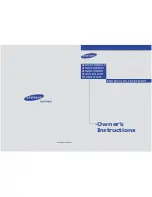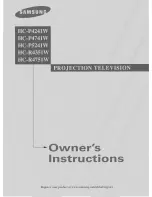
Connecting
46 - ENGLISH
Getting Started
Before connecting
z
Before connecting, carefully read the operating instructions for the external device to be connected.
z
Turn off the power of all devices before connecting cables.
z
Acquire any connection cable necessary to connect the external device to the system that is either not supplied
with the device or not available as an option.
z
Video signals containing too much jitter may cause the images on the screen to randomly wobble or wafture. In
this case, a time base corrector (TBC) must be connected.
z
The projector accepts video signals (including Y/C signals), analog RGB signals (synchronous signals are TTL
level), and digital signals.
z
Some computer models are not compatible with the projector.
z
Use a cable compensator when you connect devices to the projector using long cables. Otherwise the image
may not display properly.
z
Refer to “List of compatible signals” (
page 174) for the types of video signals that can be used with the
projector.
▶
■
<RGB 2 IN> terminal pin assignments and signal names
Outside view
Pin No.
Signal name
(4)
and
(9)
are not used.
(5)
-
(8)
,
(10)
, and
(11)
are GND
terminals.
(10)
(6)
(11)
(15)
(1)
(5)
(1)
R/P
R
(2)
G/G, SYNC/Y
(3)
B/P
B
(12)
DDC data
(13)
HD/SYNC
(14)
VD
(15)
DDC clock
▶
■
<HDMI IN> terminal pin assignments and signal names
Outside view
Pin No.
Signal name
Pin No.
Signal name
(1)
T.M.D.S data 2+
(11)
T.M.D.S clock shield
(2)
T.M.D.S data 2 shield
(12)
T.M.D.S clock–
Even-numbered pins
(2)
to
(18)
(3)
T.M.D.S data 2–
(13)
CEC
(1)
(19)
(2)
(18)
(4)
T.M.D.S data 1+
(14)
—
(5)
T.M.D.S data 1 shield
(15)
SCL
(6)
T.M.D.S data 1–
(16)
SDA
(7)
T.M.D.S data 0+
(17)
DDC/CEC
GND
Odd-numbered pins
(1)
to
(19)
(8)
T.M.D.S data 0 shield
(18)
+5 V
(9)
T.M.D.S data 0–
(19)
Hot plug detection
(10)
T.M.D.S clock+
Connecting
















































